

Friday after lunch Armando and I got in my car and headed for the Leuseni on the Romanian border. The road to Leuseni is one of the best in Moldova. It is straight, reasonably smooth and, most importantly, it avoids all the villages. There is little traffic so even though it is only two lanes we made good time. There are five steps to go through in crossing the border: Modovan customs and immigration, Romanian customs and immigration plus a car wash to disinfect the car. We were at the front of the line and it all went smoothly except for a brief delay while the Romanian immigration official checked with a superior somewhere about the regulation that holders of Peruvian passports must show that they have $100 for each day they plan to stay in Romania. We planned for only three days but Armando's visa was good for thirty days and he did not have $3000. After fifteen minutes or so the got a satisfactory answer and we were on our way.
The road from the border to Iasi (pronounced "yash") is only 40 miles long but it seemed as though we were always going through villages so it was a slower ride. In Iasi we found an exchange booth open for 24 hours ("non stop" as they say here), exchanged a little money and headed for Suceava ("soo-CHA-va"). Iasi is now the capital of the part of Romania called Moldavia but a few hundred years ago the capital was in Suceava. We arrived at dusk and found an inexpensive but comfortable hotel on the outskirts of town. Between the two of us we knew enough Romanian to get directions and make the necessary arrangements at the hotel. We ate dinner at a small restaurant next to the hotel overlooking a car wash. The car wash had a high-pressure hose and several men with mops and brushes working in the middle of a parking lot. Between cars one man used the hose and a mop to clean a large carpet.
After dinner we drove downtown to see what was in the city. We parked on a street where some shops were still open and young people were strolling. We found the local MacDonalds, an old church, a second church with a watch tower inside a walled fortress, then a pedestrian mall. There we asked a young man which way to the center of the city. He answered that we were already there. Then we asked where we should go for a short walk to see more of the city. He said that Suceava is a small city and that the only activity was at some discos. We walked a bit further, made a big circle and decided that he was right.
The next morning, after a good breakfast at the hotel we drove back downtown. Our map and guidebook said that we should walk downhill, through a park, across a river and then up a hill to the remains of a castle. After parking we headed in the direction suggested by the map but didn't see a park. We asked someone which way to the castle and he pointed us down a road. We followed the road until it ended and asked a boy which way. He pointed straight ahead so we continued. The road ended but there was a path. At the bottom of the hill was a concrete-lined drainage ditch that we stepped across but no sign of a river. We did see a wide concrete walkway with brick steps going up the other side, so up we went.
At the top we found a big parking lot and the entrance to the castle. We paid our 10,000 lei (30 cents) and walked in. First we had to go around a large moat. We crossed a bridge and went inside the walls. Now there are only ruins. We found stairways that took us to the top of very thick walls where we ignored signs in Romanian that probably told us not to walk up.
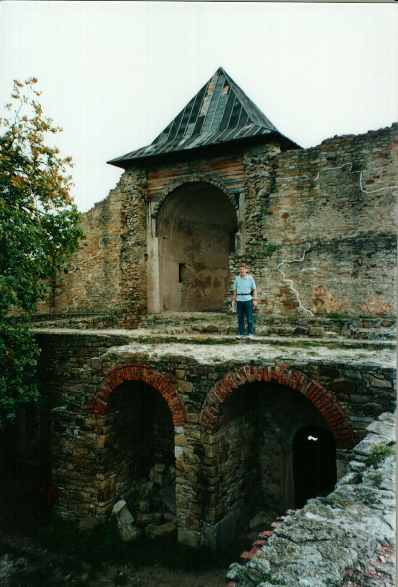
Nearby was a big statue of Stefan Cel Mare ("The Great"), the king who ruled Moldova 500 years ago and won many battles with the Turks. We were interested because we knew that he was revered in the Republic of Moldova where the biggest street in Chisinau is named after him and we have many statues of him but we hadn't realized that he was also so important in Romania.
We stopped at MacDonalds long enough for Armando to use the clean rest room and for me to eat some ice cream. Then we headed for a Chinese market we had seen on our way into the city. They had a large assortment of imported food, clothing and inexpensive goods but we were disappointed that they didn't have any Chinese food. Apparently the owners were Chinese but there wasn't much of a market here for Chinese food.
Now it was time to head for the painted monasteries that make this area famous. Most Orthodox churches in this part of the world had extensive frescoes covering the inside walls, but here they also painted frescoes on the outsides. In the past five hundred years some of the paint has faded, especially on the northern walls, but it is amazing how much has survived.

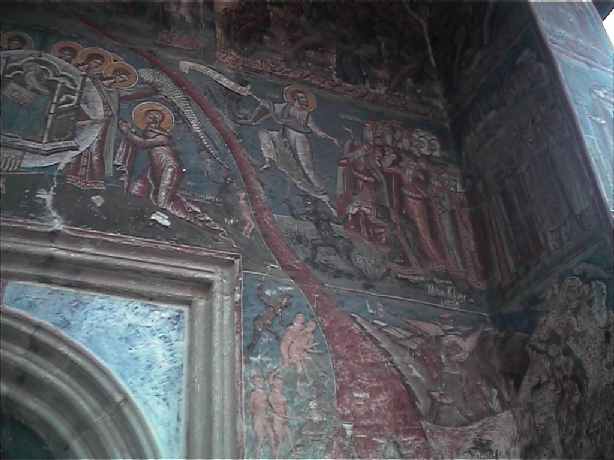
Our first monastery is called Humor. It is near the town of Gura Humorului which means "humor's mouth". Nobody has been able to explain the name to me yet. We climbed the tower and saw the nuns working outside their houses. They were picking the best potatoes out of a huge pile, bagging them and hauling them to a basement to store for the winter.
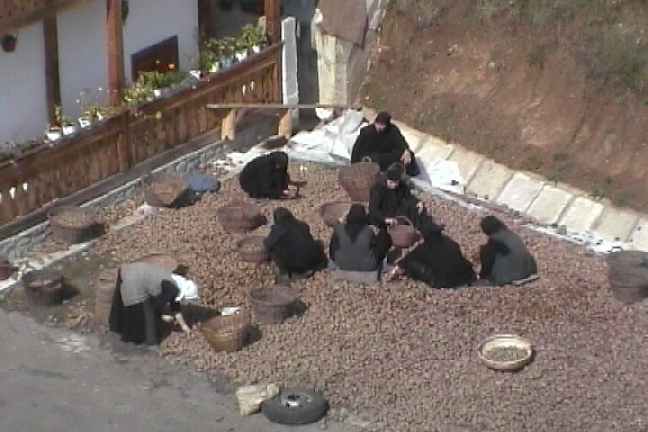
We drove through some beautiful countryside between the monasteries. Moldova has rolling hills and farm land that is pretty, but this part of Romania has much larger hills that are covered with forests. Wood is relatively scarce in Moldova and much of Romania so houses are built from adobe or cinder blocks covered with stucco. Here we saw many wood houses.
We saw signs for small hotels in the country (called pensions) and we tried to eat lunch at one. Unfortunately they had a large group that had taken over the whole place and we had to find a restaurant in a nearby town instead.
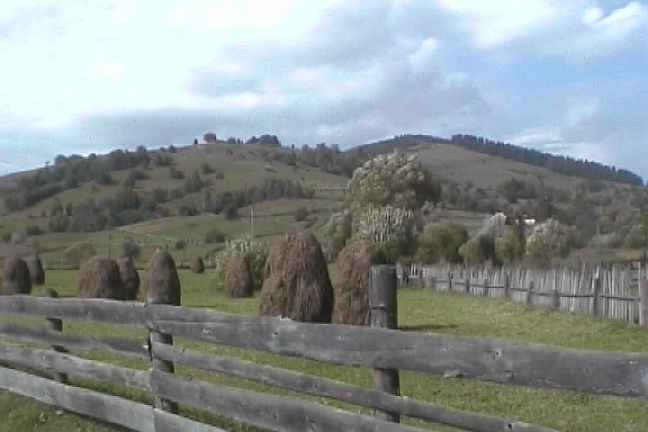
After our late lunch we found lots of beautiful countryside and three more painted monasteries. We drove though a pass between two mountains covered with forests. One advantage of that route was that because there were no villages or pasture here we did not have to stop and wait for cows coming home the way we often did in the early evening on other roads.
Sunday morning after a breakfast of ham and cheese omelets we started hunting for three more monasteries. The guidebook and the map gave different directions to find the first one, Dragomima. We followed the guidebook. Soon we came to a sign announcing a nature reserve and a gate across the road. We asked a woman how to get to the monastery and she pointed straight ahead and unlocked the gate for us. The road was made of very loose gravel. We passed a steam roller but it was just parked there. After a while we came to another gate that was locked. This time we didn't see anyone to ask. We were not looking forward to driving all the way back and figuring out an alternative route. Suddenly a car drove up, a man got out and unlocked the gate. We thanked him and saw the monastery just around the corner.
It was Sunday morning and dozens of people were inside. I thought maybe we wouldn't have to pay the usual 65 cent admission charge, but it didn't take long for a nun to figure out that we were tourists not worshipers and to collect the fee. The guidebook explained that this monastery was as tall as it was long and very narrow. Even from outside of the walls surrounding it we could see it towering over everything. Outside the walls were apple orchards, cow pastures and a pond. We walked around the pond and admired the scenery. Across the road was another pond. This one had a large café, tables under the trees and more tables on a wharf in the pond. It wasn't lunch time yet so we pushed on.
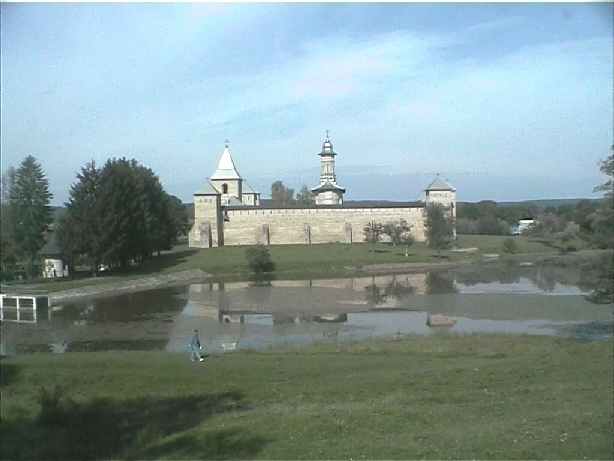
At the next monastery a service was just ending as we arrived. People were walking out of the church carrying plastic buckets filled with ring-shaped loaves of bread and drinking wine. The attendant explained that six weeks after someone dies a special service is held for them and the family offers this bread to everyone. They gave us each a miniature loaf. Armando had some wine while I had the fruit juice since I was driving. I took a picture of the group and promised to send them a copy.


After lunch and one final monastery it was time to head towards home. We had two more stops planned. The first was the winery in Cotnari where they make a sweet white wine. The map showed two ways to get there. One alternative was to go back the way we had come then double back on a side road. The second was to take a series of smaller roads in a more direct route. Of course we opted for the more interesting alternative. At first the road was small but smooth and straight with signs directing us to the next town. Gradually the road deteriorated as we progressed and there were few signs to point us on our way. Our pace slowed and we asked numerous people for directions but we had no problem finding Cotnari. We bought a small carton of wine to share and headed for Iasi.
Our final destination was Metro, a huge discount warehouse store like Costco or BJ's in the US. I don't think Moldova has a store one-tenth that size. We arrived five minutes before closing time and were pleased that they let us in. I bought some tuna fish, salad dressing and taco sauce (none of which I have seen in Moldova) and we headed home.
At the border crossing we met a friendly Romanian immigration official we had talked with before. He remembered us and waived the usual 25,000 lei (80 cent) fee for the car. Hardly anyone else was heading to Moldova at 8:30 on a Sunday night so we got through quickly and made it home in time for a good night's sleep before work on Monday.